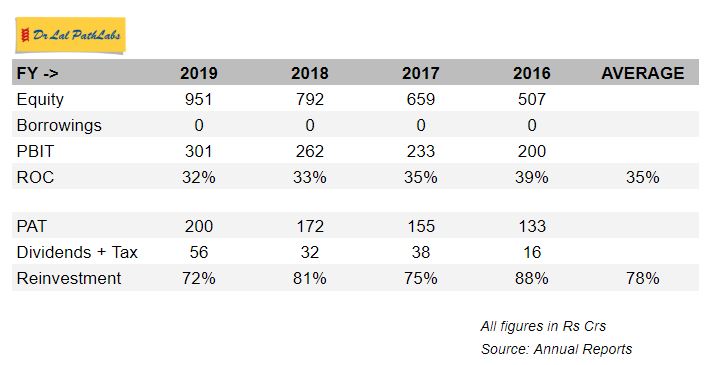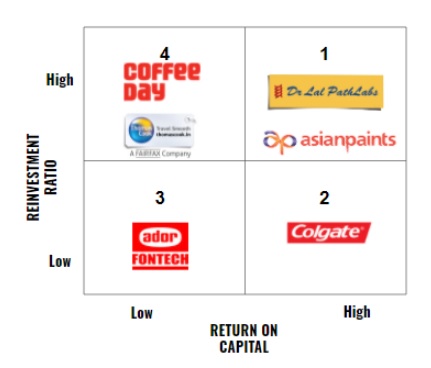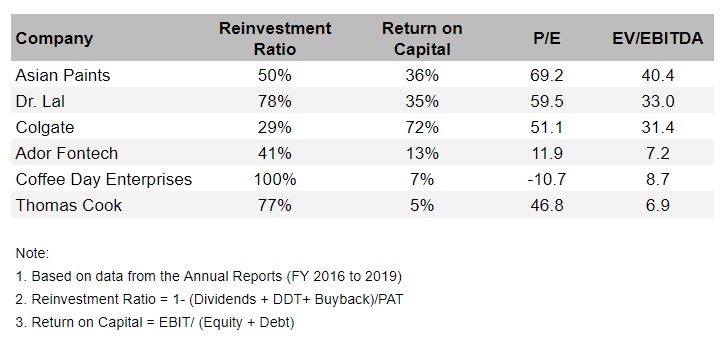This article first appeared on Capitalmind.in.
As you may recall from high school Physics, the efficiency of a machine is calculated as the ratio of its output to its input. You could apply this idea of efficiency to businesses as well. In this case, the input is the capital that you supply in the form of equity and debt. The output would be the profits that the business generates. The efficiency of the business at deploying capital is the ratio of profits to the input capital. What physicists call Efficiency, finance professionals call Return on Capital.
Companies that have competitive advantages can more efficiently convert input capital into profitable output. Take the case of Colgate. The name is synonymous with oral care and oral care is synonymous with Colgate. It has over 50% market share in the oral care segment and is present in every nook and corner of India. It achieved all of that through investments in branding and marketing, educating the market, building associations with dentists and schools, distribution and much more. All of those investments in the past have yielded it the efficiency of converting input capital to profits at the rate of 72% as of today!
As per the Balance Sheet of FY 2019, Colgate had Equity + Debt of Rs 1524 Crs. It generated a Profit Before Interest and Taxes (PBIT) of Rs 1114 Crs, giving it an efficiency of 72%.

From Physics, lets now switch to high school Mathematics. We know that Compound Interest far outperforms Simple Interest simply because it can reinvest the interest every year. Likewise, businesses with high Return on Capital that can reinvest profits, would far outperform businesses that can’t reinvest.
Now, Colgate which has a high Return On Capital can reinvest only 29% of its profits back, averaged over 4 years, into the business.

Contrast that with Dr Lal Pathlabs, an emerging pathological and diagnostics brand in India. It has a Return on Capital of 35%, but reinvests 78% back into its business in building regional reference labs and acquiring smaller competitors etc. And since the unorganized market is 85%, it has a long runway ahead of it.

The concepts of Return on Capital and Reinvestment Ratio can be illustrated with a 2X2 matrix as below. You can view the data here.


Quadrant 1 (high ROC and high Reinvestment): Some of the simplest and best ideas can come from this quadrant. These are companies that have high Return on Capital and the ability to reinvest, kind of like have your cake and eat it too.
Quadrant 2 (high ROC, low Reinvestment): Most of the businesses in this quadrant usually return cash to shareholders in the form of dividends or buybacks. Therefore these businesses, like Colgate, can be compared to a high quality bond with some growth on the upside and minimal downside. They can offer very high dividend yields when purchased at low prices.
Quadrant 3 (low ROC, low Reinvestment). In my opinion, only investors that have painstakingly studied the nuances of the industry and it’s cycles would have an edge here. The small investor with limited understanding can give this quadrant a pass.
Quadrant 4 (low ROC, high Reinvestment). Companies that usually have very low Return on Capital and high Reinvestment usually tend to be wealth destroyers. As an example, Coffee Day Enterprises, despite having a great brand like Cafe Coffee Day, has lost over 85% of it’s market cap since listing on the exchange! It’s best to avoid these as long term investments.
For the most part, companies in Quadrant 1 and Quadrant 2 are expensive. But once in a while, the Markets do panic and irrationally beat down the prices of these companies (e.g. Nestle during the Maggi crisis, Infosys when Dr. Sikka resigned and Bajaj Finance during demonetization). Investors should turn bargain hunters at such times.
There are over 6000 companies listed in India. But among them, a small subset of companies have Return on Capital > 20%. Even fewer companies have the runway to reinvest profits of at least 50% for a long period of time. Therefore, it pays to narrow down the field to a smaller investable universe where one can gain an edge by focusing on the nuts and bolts of the businesses.
